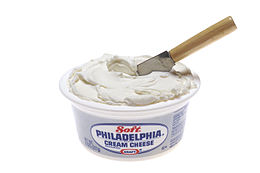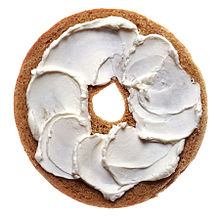The following article was sourced from a Wikipedia page at the following address:
http://en.wikipedia.org/wiki/Cream_cheese
CREAM CHEESE

Cream cheese is a soft, mild-tasting fresh cheese typically made with a high fat content. Low-fat versions also exist, and their consistency is improved by stabilizers such as carob bean gum and carrageenan.
The US Food and Drug Administration defines cream cheese as containing at least 33% milk fat with a moisture content of not more than 55%, and a pH range of 4.4 to 4.9. In other countries, it is defined differently and may need a considerably higher fat content.
Cream cheese is not naturally matured and is meant to be consumed fresh, and so it differs from other soft cheeses such as Brie and Neufchâtel. It is more comparable in taste, texture and production methods to Boursin and Mascarpone.
ORIGIN
Europe
Early prototypes of cream cheese were referenced in England as early as 1583 and in France as early as 1651. Recipes are recorded soon after 1754, particularly from Lincolnshire and the southwest of England.
United States
Recipes for cream cheese can be found in US cookbooks and newspapers beginning in the mid-eighteenth century. By the 1820s, Philadelphia and its environs had gained a reputation for this cheese. The cheese, however, was produced on family farms and so quantities for distribution were small. Around 1873, William A. Lawrence, a Chester, NY, dairyman, was the first to mass-produce cream cheese. In 1873 he purchased a Neufchatel factory and shortly thereafter, by adding cream to the process, was able to create a richer cheese, that he called “cream cheese”. In 1877 he created the first brand for cream cheese: the silhouette of a cow followed by the words: Neufchatel & Cream Cheese. In 1879, in order to create a larger factory, Lawrence partnered with a Chester merchant, Samuel S Durland. In 1880, Alvah L Reynolds, a New York cheese distributor, began to sell the cheese of Lawrence & Durland and created a brand name for it: Philadelphia Cream Cheese. Reynolds chose the name based on the reputation Philadelphia had for such cheese. By the end of 1880, faced with increasing demand for his Philadelphia brand, Reynolds turned to Charles Green, a second Chester dairyman, who, by 1880, had been manufacturing cream cheese. Some of Green’s cheese was, now, also sold under the Philadelphia label. In 1892, Reynolds bought the Empire Cheese Co. of South Edmeston, NY to produce cheese under his Philadelphia label. When that burned down in 1900, he turned, the following year, to the newly formed Phenix Cheese Co. to produce his cheese. In 1903, Reynolds sold the rights to his Philadelphia brand to Phenix Cheese Company under the control of Jason F. Whitney, Sr. (which merged with Kraft in 1928). By the early 1880s, in addition to Philadelphia brand, was Star, a second cream cheese brand of Lawrence & Durland, and Green’s World and Globe brands. At the turn of the 19th century, New York dairymen were producing cream cheese for a number of other brands: Double Cream (C. Percival); Eagle (F.X. Baumert); Pong Cheese; Empire (Phenix Cheese Co.); Mohican (International Cheese Co.); Monroe Cheese Co. (Gross & Hoffman); and Nabob (F.H. Legget).
USES

Cream cheese on a bagel
Cream cheese is often spread on bread, bagels, crackers, etc., and used as a dip for potato chips and similar snack items, and in salads. It can be mixed with other ingredients to make spreads, such as yogurt-cream spread (1.25 parts cream cheese, 1 part yogurt, whipped).
Cream cheese can be used for many purposes in sweet and savoury cookery, and is in the same family of ingredients as other milk products, such as cream, milk, butter, and yogurt. It can be used in cooking to make cheesecake and to thicken sauces and make them creamy. Cream cheese is sometimes used in place of or with butter (typically two parts cream cheese to one part butter) when making cakes or cookies, and cream cheese frosting. It is the main ingredient in the filling of crab rangoon, an appetizer commonly served at US Chinese restaurants. It can also be used instead of butter or olive oil in mashed potatoes. It is also commonly used in some western-style sushi rolls.
American cream cheese tends to have lower fat content than elsewhere, but "Philadelphia" branded cheese is sometimes suggested as a substitute for petit suisse.
Manufacture
Cream cheese is easy to make at home, and many methods and recipes are used. Consistent, reliable, commercial manufacture is more difficult. Normally, protein molecules in milk have a negative surface charge, which keeps milk in a liquid state; the molecules act as surfactants, forming micelles around the particles of fat and keeping them in emulsion. Lactic acid bacteria are added to pasteurized and homogenized milk. During the fermentation at around 22 °C (72 °F), the pH of the milk decreases (it becomes more acidic). Amino acids at the surface of the proteins begin losing charge and become neutral, turning the fat micelles from hydrophilic to hydrophobic state and causing the liquid to coagulate. If the bacteria are left in the milk too long, the pH lowers further, the micelles attain a positive charge and the mixture returns to liquid form. The key, then, is to kill the bacteria by heating the mixture to 52–63 °C (126–145 °F) at the moment the cheese is at the isoelectric point, meaning the state at which half the ionizable surface amino acids of the proteins are positively charged and half are negative.
Inaccurate timing of the heating can produce inferior or unsalable cheese due to variations in flavour and texture. Cream cheese has a higher fat content than other cheeses, and fat repels water, which tends to separate from the cheese; this can be avoided in commercial production by adding stabilizers such as guar or carob gums to prolong its shelf life.
In Spain and Mexico, cream cheese is sometimes called by the generic name queso filadelfia, following the marketing of Philadelphia branded cream cheese by Kraft Foods.
To read more about cream cheese, please click on the following link:
http://en.wikipedia.org/wiki/Cream_cheese
